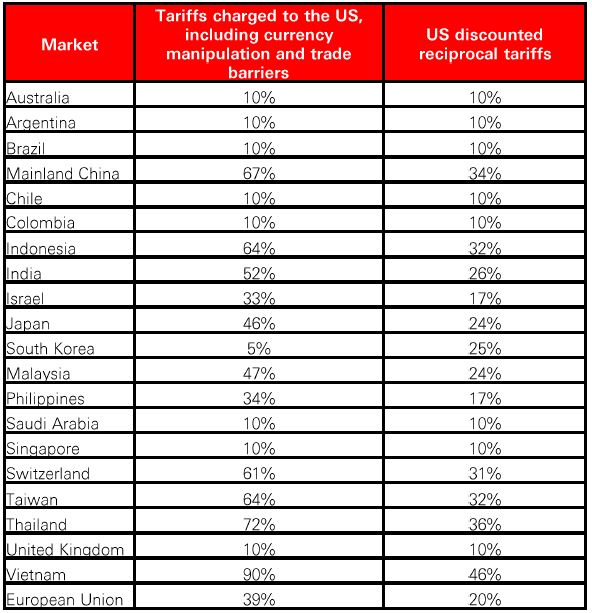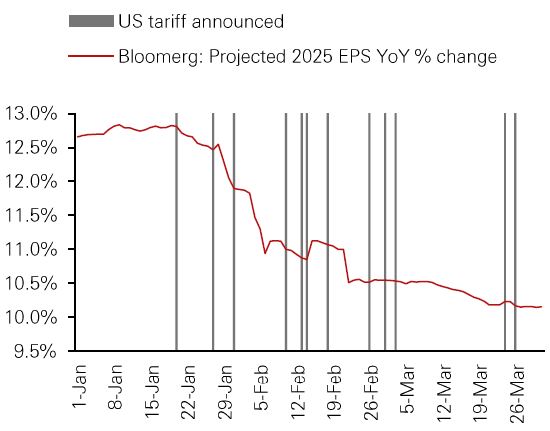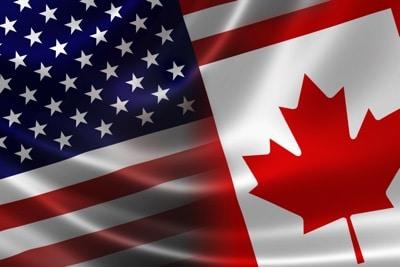
Economic Updates
Special Coverage: ‘Liberation Day’ an opening salvo to negotiate creates further uncertainty
georgemiller
Publish Date: Thu, 03 Apr 2025, 12:02 PM

Key takeaways
- The US has announced a 10% baseline tariff along with individual reciprocal tariffs of up to 49% on some economies. Uncertainty will remain elevated as trade partners respond.
- The tariffs are generally towards the higher end of expectations (though Mexico and Canada are not subject to new duties) and hence a negative for risk appetite, earnings prospects, and global growth. However, they were not completely unexpected.
- Liberation Day will probably not represent the short-term bottom for US equities or USD. Much uncertainty remains about the breadth and depth of tariffs and the impact on US growth and inflation. We continue to be selective in consumer-related stocks, preferring services over goods, large cap over small cap and focusing on strong cash flow generators. We believe longer-dated safe-haven bonds will benefit as markets worry about more growth than about inflation and continue to overweight gold as a diversifier.
What happened?
The US has announced a 10% baseline tariff effective 5 April, along with additional individual reciprocal tariffs of up to 49% on some economies beginning 9 April. The previously announced 25% tariff on autos is expected to take effect from 3 April.
For the US, tariffs remain a key tool for negotiations. If maintained, the announced tariffs could cut expectations for global economic growth and corporate profits, and lift fears of supply chain disruptions and result in higher finished goods prices.
Mexico and Canada are exempt from any new tariffs as they continue to negotiate with the Trump administration on immigration, border security and the drug wars.
Many of the US trading partners should have sufficient time to at least start negotiating with the Trump Administration, and the hope is that they hold back on any retaliatory measures, which could otherwise further escalate this tension into a broader trade war.
Individual reciprocal US tariff rates for key markets

Source: The White House, HSBC Global Private Banking and Wealth as at 3 April 2025.
Key highlights of the announcements:
- Baseline tariff: President Trump will levy a baseline 10% tariff on all imports beginning 5 April under the International Emergency Economic Powers Act (IEEPA).
- Individual reciprocal tariffs: From 9 April, the US will impose higher individual (bilateral) ‘reciprocal’ tariffs on imports from economies with which it has the largest trade deficits, while other trading partners will continue to face the original 10% baseline tariff. Some products will be excluded, such as steel, aluminium and autos that are already subject to Section 232 tariffs; copper, pharmaceuticals, chips and wood; other goods that may become subject to future Section 232 duties, and bullion, energy and other critical minerals that are not available in the US.
- For vehicles that qualify for USMCA preferences, tariffs will only apply to the non-US content, but importers will need to submit the amount of US content in each model. It is also not clear whether this US administration will honour the USMCA Section 232 side letters with Canada and Mexico - which provides for a 60-day delay on Section 232 tariffs and annual duty-free import quotas for vehicles and auto parts from these markets.
We are not making further revisions to our global growth forecasts which were already lowered to 2.5% in March, due to the tariffs already announced. President Trump has indicated room for negotiation by asking the trading partners to reduce the barriers they put up to US firms. But the executive order also said tariffs could rise further if there is retaliation or if, for example, trade deficits widen.
Going forward, if Trump is able to incorporate a lower corporate tax rate (from 21% to 15%) in the next budget, it could result in an expansion of production in the US by foreign companies who choose to move production to the US. This could result in increased revenues as more production and job opportunities emerge in the US economy and would then lower the trade deficit, which is a positive factor for US financial markets.
Investment implications
Liberation Day will probably not represent the bottom for US equities. Much uncertainty remains about the breadth and depth of tariffs and the ensuing negotiations that the Trump administration is currently engaging in.
It is unlikely that we will see the net alpha shift upward in prices and subsequent resumption of disinflation in time for the Fed to ease in June. Once the market understands that the likelihood of a Fed cut in June is not properly priced in, it could create further volatility for US equities. Currently, the market is attaching a 70% probability of a Fed cut in June, which seems high.
We expect to see continued volatility in both US equities and bonds in the short term, driven by the combination of the budget battles, treasury issuance, and tariff and trade policy.
From a medium-term perspective, though, negotiations should reverse some of the tariffs, while US innovation and re-onshoring should help. There is also the potential for tax cuts to bring better news.
US tariff announcements have cut full year 2025 US earnings projections

Source: Bloomberg, US Census Bureau, HSBC Global Private Banking and Wealth as at 3 April 2025. Forecasts are subject to change.
Bloomberg’s projected 2025 EPS growth dropped from approximately 13% at the start of the year to around 10% by end of March. The downward trend accelerated in February, coinciding with more frequent and broader tariff measures.
Europe’s stock market rally may see a pause as negotiations start. Automotives are vulnerable but the absence of a pharma tariff is good news. The UK got a relatively lower tariff, but its open economy makes it vulnerable – not retaliating could help cap inflation and support gilts.
The largest US trade deficit is with China, totalling – USD295 billion, reinforcing China’s central role in the trade policy debate. In China and the rest of Asia, we continue to favour domestically oriented businesses. We also think that regional integration will further accelerate.
https://www.hsbc.com.my/wealth/insights/market-outlook/special-coverage/liberation-day-an-opening-salvo-to-negotiate-creates-further-uncertainty/

















